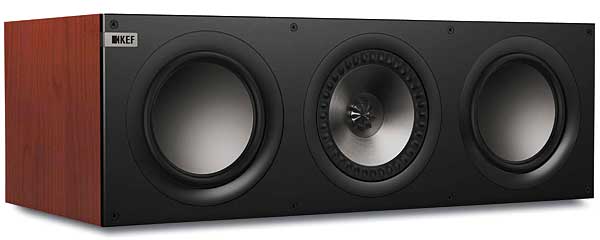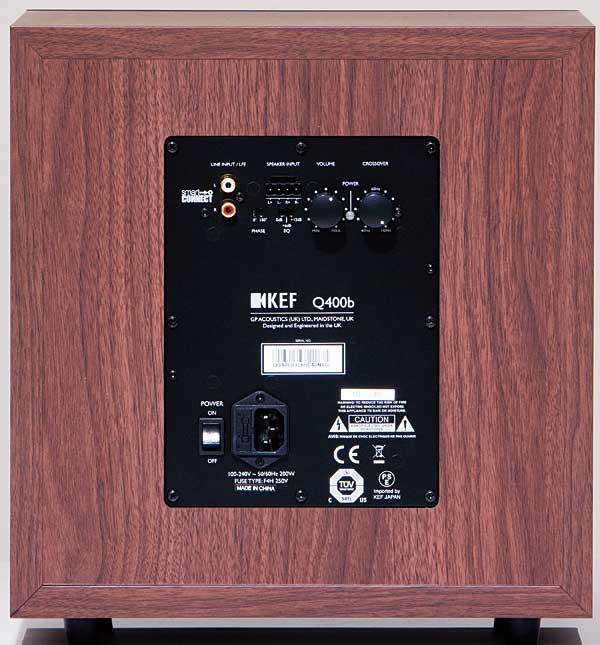For my space and the money these fair well and almost sound transparent. But get lost in the movie the sound is awesome.
KEF Q900 Speaker System Page 2
Each of the full-range Q Series speakers has two pairs of input terminals, together with a cleverly designed knob that configures them for either single-wire operation or biwire/biamp use. When turned fully clockwise, the knob shorts the terminals—plus to plus and minus to minus for normal use with a single cable. When turned counterclockwise, the knob opens the internal connection for more elaborate setups.

The only subwoofer in the Q Series is the Q400b, with a 10-inch driver and a 200-watt, Class D amp in a 1-cubic- foot sealed box. The sub has line- and speaker-level inputs, a level control, a two-position phase-shift switch (0 and 180 degrees), and an EQ switch that offers 6 dB or 12 dB of boost at 40 Hz. I turned the latter off for all of my listening. Since I use the filters in my surround processor for bass management, I set the Q400b’s filter to its 140-Hz maximum—there’s no bypass control for the subwoofer’s own low-pass filter. (For more about the technology behind the Q Series, go to kef.com.)
The aesthetics of the new Qs are pleasing if hardly cutting edge. The cabinets are fiercely rectangular and finished in what’s said to be an eco-friendly wood-pulp material. It simulates genuine wood veneer reasonably, but not spectacularly, well. What I liked best about the look of the speakers was their lack of excessive bling. Even the metal cones have a rich, subdued luster rather than a shiny, chrome-bumper look.

The Q900’s outrigger feet provide good stability, and their spikes are adjustable from the top. Because the carpeting in my room sits atop vintage oak flooring, I used the Q900s’ feet without the spikes.
Setup
I set up the KEFs in my 26-by-
15.5-by-8-foot home theater studio. I positioned the Q900s about 9 feet apart to the left
and right of my 78-inch-wide projection screen and toed them in toward the main listening position. The screen was retracted for music listening. I placed the Q600c center speaker on a low stand beneath the screen, and the Q100 surrounds sat on 24-inch stands several feet behind the listening seats.
Because the Q400b sub is small and my room is relatively large, I requested two for this review. Unless noted otherwise, I used both, positioned directly side by side. For a smaller environment or for listeners who don’t insist on action spectaculars played back at near reference level, one Q400b might well suffice. The Q400b is rated down to 28 Hz, +/–3 dB. If you prefer a single larger sub- woofer with stronger response in the bottom octave, plenty of other options are available.
A Parasound Halo A 51 power amp and an Integra DTC-9.8 surround processor drove the speakers. The primary sources were Blu-ray players from Panasonic and Pioneer. I used the Panasonic DMP-BDT350 with an HDMI connection to the Integra surround processor for movie playback. The Pioneer Elite BDP-09FD was my primary CD transport, with a digital coaxial connection to the Integra. Audio cables included vintage designs from Monster Cable, Cardas, and Kimber Kable.
All of the bass below 80 Hz, including that from the main left and right Q900s, was directed to the subwoofers except where noted. The speaker grilles were removed for all of my listening.
I Believe in Music
While the Q900s sounded good out of the box on music, they also sounded just a little congested. They were somewhat forward in the low treble and a bit airless at the top end. I broke them in over a few days of serious listening, and that sorted out the balance. The treble also opened up significantly when I changed my CD-playback source from the Panasonic Blu-
ray player to the Pioneer.
Following their initial running in, I auditioned the Q900s in two-channel stereo sans sub- woofers, and they quickly reeled me in. I know you can get more from speakers that cost considerably more than the Q900s, and KEF plays hardball in that field as well. The average enthusiast—and perhaps even more than a few rabid audiophiles—can be for- given if they wonder why they should take out a second mortgage when they can get so much for $1,600 per pair. All these speakers need is a good setup, fronted by a good source and good electronics.
The Q900s sounded uncolored, open, and detailed. They revealed virtually no trace of the edginess that is frequently (and often unfairly) attributed to speakers with metal diaphragms. I some- times missed a bit of the sparkle that characterizes other speakers that have passed through my listening room, but I appreciated the KEFs’ consistently fine per- formance across a wide range of program material. Their silky treble more than compensated, as did their come-alive quality at playback levels that will leave much of their competition begging for mercy.
The KEFs’ ability to firmly locate images from left to center to right also knocked me out. That also goes for image depth. It was merely average with the Panasonic player; with the Pioneer, it improved to com- petitive with the best I’ve heard in my room. My room is consistently good in these qualities with most competent speakers, and the KEFs did nothing to compromise a stun- ning room/speaker soundstage.
Even without a subwoofer or two in the mix, the Q900s produced satisfying bass. My rather rudimentary in-room measurements showed a rapid rolloff in response below about 50 Hz. But as positioned, well out from the walls, the speakers received relatively little help from the typical room gain. Despite this, the bass was certainly pow- erful enough to impress most listeners on most music. It was reasonably well defined, too.
- Log in or register to post comments





































































